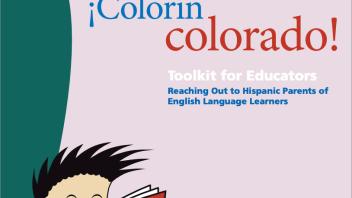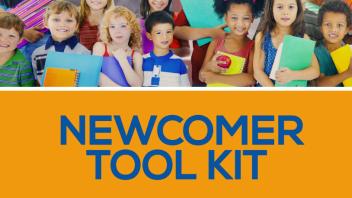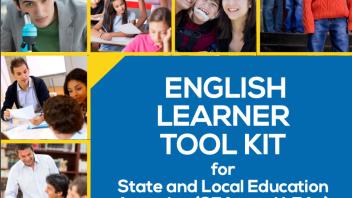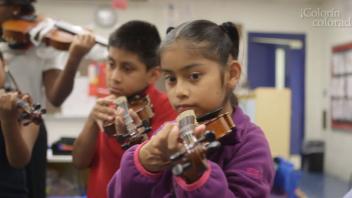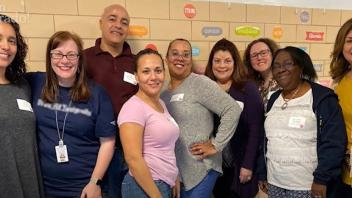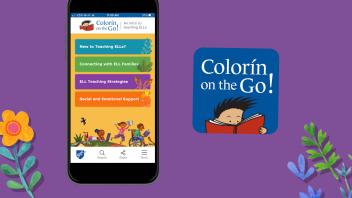When you want to connect with the families of English language learners (ELLs), there are lots of strategies you can try. It may take some time to figure out what works, but those ideas will serve you now and in the future. Here are 10 ideas from our friends at Colorín Colorado to help you get started, as well as key questions to guide you.
Family engagement
Learn about your families
An important first step is to learn more about your families. You can start by reaching out to staff who work closely with families, such as family liaisons, ESL or bilingual teachers, and paraprofessionals. You can also look for local community organizations that work with the families in your school. These groups often have important insights, resources, and ideas — and they may be able to provide volunteers and skilled interpreters.
You can also talk with families directly; however, it is important not to overwhelm families with too many questions at once, especially if they are hesitant to share any personal information. For examples, many Indigenous families from Latin America are very cautious about sharing their Indigenous languages and cultures in school settings at first.
Go slowly; it may take time to build trust. On the other hand, you may find some families who are eager to share information and ready to help.
Note: Keep in mind that the idea of “school-family partnerships” may be new to families who come from countries where family engagement in schools is not the norm.
Key questions
- What languages do our families speak?
- Which countries to they come from?
- What kinds of educational backgrounds do our families have? Is there a range of educational experiences among families?
- Are any of our families refugees or migrant farmworkers?
Learn more here: Special Populations: English Language Learners
Henry Sales, Mam Educator: How I Became an Advocate for My Indigenous Community
In this video, Indigenous educator Henry Sales (Mam) describes how he became a strong advocate for the Mam community here in the U.S. despite early challenges and discrimination. See more video clips from the Colorín Colorado interview with Henry Sales
Make families feel welcome
Look for ways to make families feel welcome in the school by:
- Posting signs in their languages throughout the school
- Displaying flags and artifacts from their home countries
- Welcoming families’ languages and cultures in the school
- Displaying bilingual books and resources in families languages
- Connecting families with bilingual staff who can answer their questions
- Getting to know families and learning about their interests, talents, skills, and strengths
- Hosting social events where families can meet each other and school staff
In addition, it’s important to ensure that families have updated information in their language about school events and activities and that they know they can contact the school at any time with questions.
Key questions
- How welcoming is our school environment currently? How can we make it more welcoming?
- What has made families feel welcome in the past?
A warm welcome for immigrant families in the front office
Norieah Ahmed, the Child Accounting Secretary at Salina Elementary School in Dearborn, MI, talks about her role in welcoming newcomer immigrant families to the school from the moment they walk in the door
Share ideas with families on how they can support language and literacy at home
There are many ways that multilingual families can support their children’s language and literacy development by continuing to use their home language — which supports students’ bilingual development in that language and in English . These include singing songs and sharing/reading books in their home languages. For more ideas, see Colorín Colorado’s multilingual video series and the related multilingual tip sheets and family outreach guides that accompany them.
Key questions
- How does your school community welcome and support families’ languages?
Connect families with social-emotional supports
Make sure that families know which supports are available through the school and in the community. This might include mental health support (through a school counselor or community counselor); meal, clothing, medical, and housing support; and other enrichment or mentorship opportunities. There may also be some issues that are impacting multiple families that could be addressed by broader school-wide solutions.
Key questions
- What issues are currently impacting our families?
- What supports are available to address those issues?
- Do families have information about those supports in their home languages?
Manuela Santos: How a cultural difference impacted an immigrant family’s access to school meal funds
Community Facilitator Manuela Santos shares the story of a mother who couldn’t access grocery funds on a debit card provided to families during COVID-19 due to a cultural difference.
Ask your families for their ideas and questions
ELL families may have a range of ideas, questions, and concerns for the school. Understanding those concerns will help schools partner with families more effectively. These may include questions related to their children’s instruction, activities, services, or support, as well as ideas for how to welcome and engage families at the school. For example, families may be able to identify special events or traditions that the community would appreciate celebrating at the school.
Key questions
- When do we invite families to share their concerns and ideas?
- How can we make that easier?
Look for ways to expand access to family engagement opportunities
As you look at your current family engagement, what is working? What isn’t? Are there any barriers to participation (such as schedule, transportation, or child care)? This is an important opportunity to try something new! Perhaps an event held near families’ homes might be more accessible or providing some child care might make it easier for families to attend. Talk with families to find out what would work for them and if there are reasons they are hesitant or unable to attend events currently. Think about how you can plan activities that reflect their interests as well as their situations.
Key questions
- What has improved access to family engagement for our families?
- What barriers are there and how can they be removed?
Communication
Ensure families have language access
Multilingual families have a legal right to information in their home language from the school. Find out what language access methods your school district provides (such as interpreters, translated documents, and language lines) and how those options work. In addition, make sure that families understand how to access those options when they need to communicate with the school. (If your school does not seem to providing appropriate access, talk with an administrator about your concerns.)
Key questions
- What kinds of interpretation and translation options do we have?
- Do I know how to access them?
- Do our families know how to access them?
Dr. Jennifer Love: What do school districts need to know about language access?
This helpful overview about what language access means for school districts is a great introduction to the requirements, best practices, and funding streams related to language access in public education. This interview features Dr. Jennifer Love, the Supervisor of Language Access and Engagement in Prince George’s County Public Schools, Maryland. In the clip below, Dr. Love offers some ideas on how districts can improve and expand their language access for multilingual families. Watch the full interview
Find out how and when families prefer to communicate
Families may have preferences about how and when they communicate. For example, some families prefer texting, while others prefer phone calls or social media updates. You may find that families already have active social networks with each other and are using certain platforms frequently. In addition, it’s important to keep in mind that families’ schedules can vary significantly, especially if they are working multiple jobs and different shifts, which means that after-school or evening events may not be accessible. Some families may also work for employers who have strict rules about answering texts or calls on the job. By taking families’ preferences into account, you are much more likely to establish effective communication on a regular basis.
Key questions
- How do our families prefer to communicate?
- Are there better times of day for some of them?
- Do a lot of families work for a specific industry or company in the community? If so, does that impact their schedule?
Partnering with families in Las Vegas
Juliana Urtubey, the 2021 National Teacher of the Year, talks about the importance of flexibility and good communication when partnering with families in the service industry, such as her students’ families in Las Vegas.
Keep families’ contact information updated
It’s essential that schools have accurate contact information for families . This is important in the case of an emergency and in order to keep families connected with the school (as seen during the COVID-19 pandemic). It’s also important for schools to keep in mind that families’ contact information might change; families who use prepaid cell phones, for example, may get new phone numbers frequently. Giving families information on how and why to keep their contact information is critical.
Key questions
- How do families update contact information in our school?
- Do we make sure that process is clear for families, with explanations in their languages?
Ensure that all staff understand families’ legal rights
It’s important for school staff to know that all students have the right to a free, public K-12 education, regardless of their immigration status or that of their parents. This includes access to services and programs such as free- and reduced-priced meals, English-language development classes, special education, and school activities. In addition, ELLs who need special education services are entitled to both sets of services. For further information, see our guide related to supporting immigrant students in school settings .
Key questions
- How familiar is our staff with students’ and families’ legal rights? Is there training or information that would improve people’s knowledge?
More resources on connecting with ELL families
Launching Young Readers
Becoming Bilingual
Guides and Toolkits
Newcomer Toolkit
Guides and Toolkits
English Learner Tool Kit
Great resources from Colorín Colorado
Colorín on the Go!
100+ ELL strategies to share!




